.gif) Cowpea weevils on various beans commonly found in the home.
Cowpea weevils on various beans commonly found in the home.- Introduction
- Stored Product Pests in Southern Homes
- Indianmeal moth
- Sawtoothed grain beetle
- Red flour beetle
- Rice weevil
- Cowpea weevil
- Warehouse beetle
- Drugstore beetle
- Solving a Current Infestation of Stored Product Pests
- Preventing Future Infestations of Stored Product Pests
- Summary
- Acknowledgment
- Useful References
Introduction
Several dozen insect species infest food and non-food products of plant and animal origin commonly found in homes. Collectively, this group of insects is referred to as stored product pests. Most are small beetles or moths. For homeowners, often the first sign of a stored product pest infestation is the sudden, unexplained and then persistent presence of numerous insects in a particular area of the home. If food is not limited, populations of stored product pests can multiply rapidly and become widespread and sustained. This publication discusses the identification and control of several of the most common species of stored product pests found in southern homes.
The life cycle of stored product beetle and moth pests includes an egg stage, several larval stages, a pupal stage, and finally an adult stage. Adults often mate soon after emergence from the pupa and immediately begin their search to find food. During their lifetime, females lay approximately 100 to 1,000 eggs, depending upon the species. After deposition, eggs incubate for days to weeks. Following egg hatch, larvae develop through a series of instars while infesting and consuming their food resource (discussed below), where they remain mostly unseen. Each successive instar is larger in size and consumes greater amounts of food than the previous instar. Larval development requires weeks to a month or more to complete. The last larval instar pupates and then an adult emerges a short time later. Under optimum conditions (warm temperatures and high humidity), most stored product pests can complete a life cycle in just four to five weeks. For most species of stored product pests, there are multiple generations per year.
In some species of stored product pests, only the larval stages consume food. In these cases, the sole purpose of the adult insect is to mate, discover a food resource, and deposit their eggs—all within the few days or weeks they remain alive. Insect species in which the adults also feed can be long-lived and survive and continue to infest and feed on susceptible foods for several months to a year.
Stored Product Pest Food Items
Stored product pests vary widely in their food preferences. A partial list of edible food items susceptible to infestation include breakfast foods (especially hot and cold cereals), flour, cake mix, cookies, cornmeal, grits, dry soups, dried herbs and spices, candy, chocolate, rice, dried fruits and vegetables, popped and un-popped popcorn, peas, beans, corn kernels, nuts and seeds (of all kinds of plants), crackers, shelled and unshelled peanuts, powdered milk and protein (e.g., meat and chicken flavorings), biscuit mix, and pasta. Non-consumable items that are potential food sources for stored product pests include dried flower arrangements (such as pot pourri), rodent baits, bird seed, dry pet food, animal products made into treats (e.g., rawhides), dog bones and related treats, dried fish and fishmeal, cigars and other tobacco products, decorative wall and table arrangements containing plant or animal material, dried fruit peels, jewelry or holiday decorations containing nuts or seeds (especially corn kernels), bean bags, door stops filled with beans, corn, or rice, and stashes of food (mainly seeds) stockpiled by birds and rodents in wall voids, attics, crawlspaces, and chimneys.
Stored Product Pests in Southern Homes
Indianmeal moth
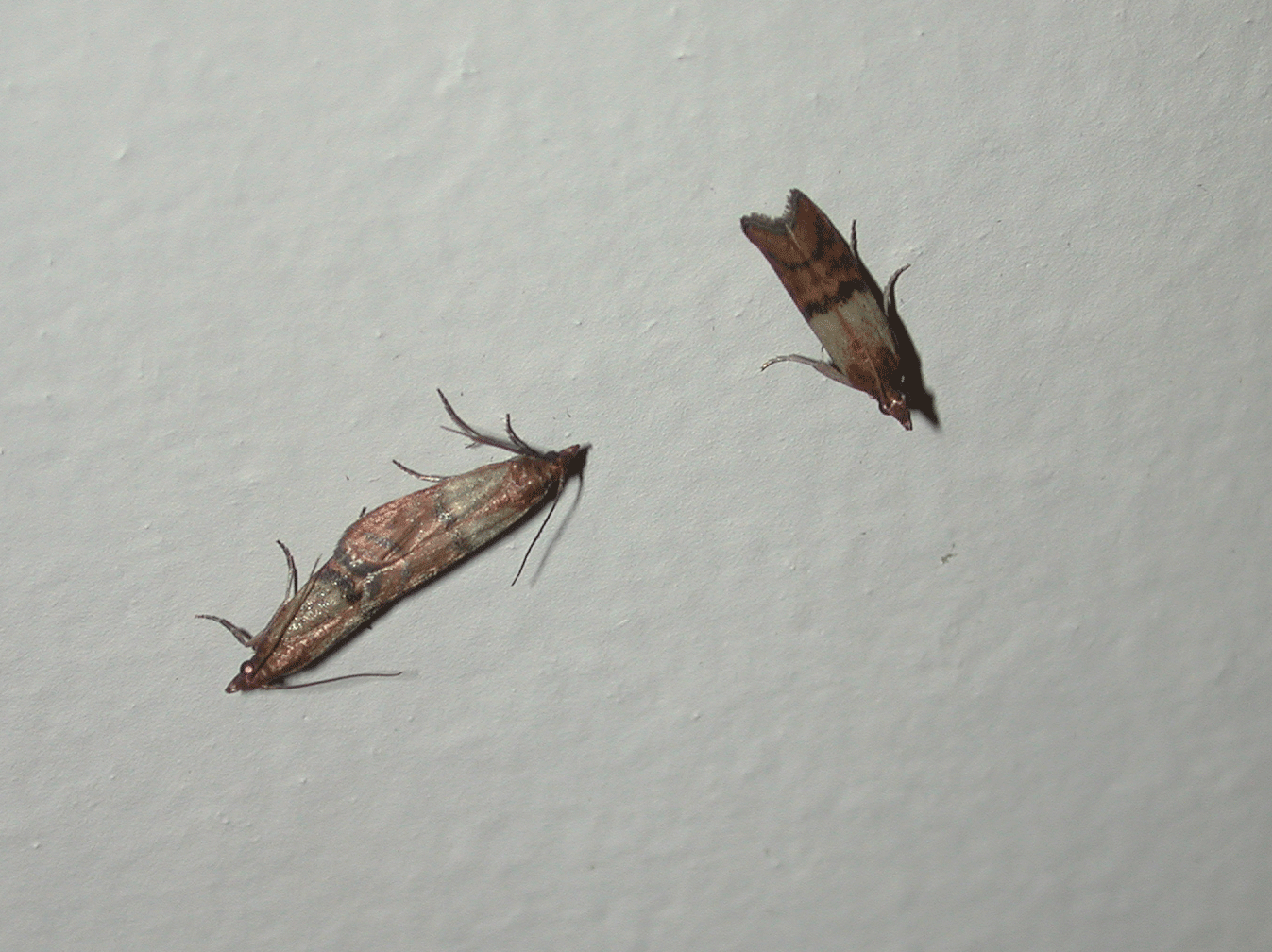 Figure 1A. The Indianmeal moth (approximately 1/2 inch long) is the most common stored product pest found in homes, where it commonly infests cereal and other grain-based foods.
Figure 1A. The Indianmeal moth (approximately 1/2 inch long) is the most common stored product pest found in homes, where it commonly infests cereal and other grain-based foods.The Indianmeal moth, Plodia interpunctella, is the most common stored product pest in homes, where it infests bird seed, breakfast cereals, and other consumables. Indianmeal moths are most commonly found infesting food items in kitchen cupboards, but adults may be found throughout the home because they are excellent fliers and readily disperse from the food item they are infesting. Adults may be found well-away from the larval food source.
Adult Indianmeal moths are distinctive in appearance. Their wings are bi-colored, and alternate between beige and copper (Figure 1A). Moths are most active at dusk, when they can be seen (indoors) flying while searching for mates and food. During the day, moths can be found resting motionless on walls and ceilings, often near their larval food source. Adults are shortlived and do not feed.
Indianmeal moth larvae, just before they pupate, are approximately 5/8 inch long, cylindrical, and dirty-white to a faint pink or green color (Figure 1B). Larvae produce visible silk webbing in the items they infest (Figure 1C) and generally pupate close to the items they are infesting. Just prior to pupation, larvae crawl away from their feeding site to pupate at the intersection of a ceiling and wall or similar seam within the cupboard, including spaces between walls and shelves and in the tight folds of packaging. Another favorite pupation site is between the corrugations of cardboard boxes. When looking for Indianmeal moths, inspectors should look between a product's cardboard box and liner by lifting the liner out of the box.
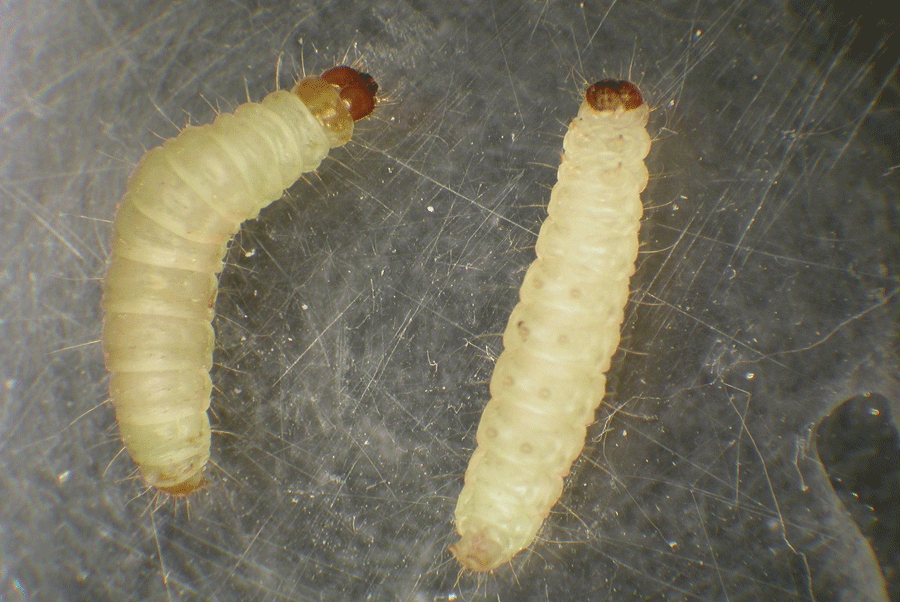 Figure 1B. Indianmeal moth larvae (approximately 5/8 inch long and dirty-white to pink to greenish colored) often crawl away from feeding sites before they pupate.
Figure 1B. Indianmeal moth larvae (approximately 5/8 inch long and dirty-white to pink to greenish colored) often crawl away from feeding sites before they pupate.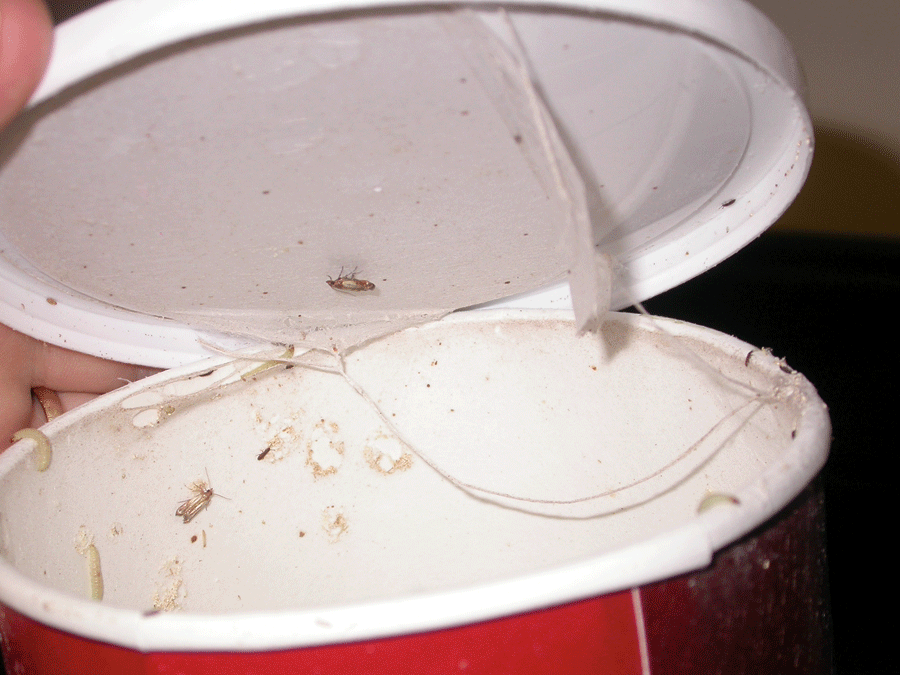 Figure 1C. A telltale sign of Indianmeal moth infestation is the presence of silk webbing produced by larvae.
Figure 1C. A telltale sign of Indianmeal moth infestation is the presence of silk webbing produced by larvae.Sawtoothed grain beetles
Oryzaephilus surinamensis, are nearly as common as the Indianmeal moth, and infest many of the same foods (especially bird seed, breakfast cereals, chocolate, and dried fruits and nuts). Adults are small (approximately 1/16 to 1/8 inch long) and flat and can be identified, aided by use of a hand lens or magnifying glass, by the row of pointed teeth located on each side of the thorax, just behind the head (Figure 2B). Their small size allows easy entry into small or minute cracks, including creases in food packaging. Sawtoothed grain beetles sometimes hide in and around outside layers of packaging and then enter when the package is opened. Adult beetles are most commonly found in the kitchen in or near their food source. Although they do not commonly fly, sawtoothed grain beetle adults are very active, long-lived (6-8 months or more), and the adults feed.
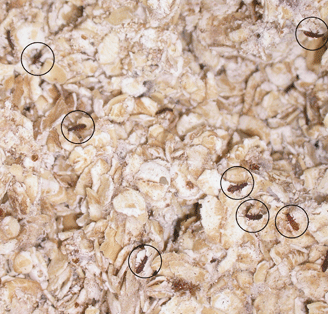 Figure 2A. Sawtoothed grain beetles are very small (approximately 1/16 to 1/8 inch long) insects that infest many of the same foods as Indianmeal moths. Shown here (circled) are adult sawtoothed grain beetles infesting oatmeal.
Figure 2A. Sawtoothed grain beetles are very small (approximately 1/16 to 1/8 inch long) insects that infest many of the same foods as Indianmeal moths. Shown here (circled) are adult sawtoothed grain beetles infesting oatmeal.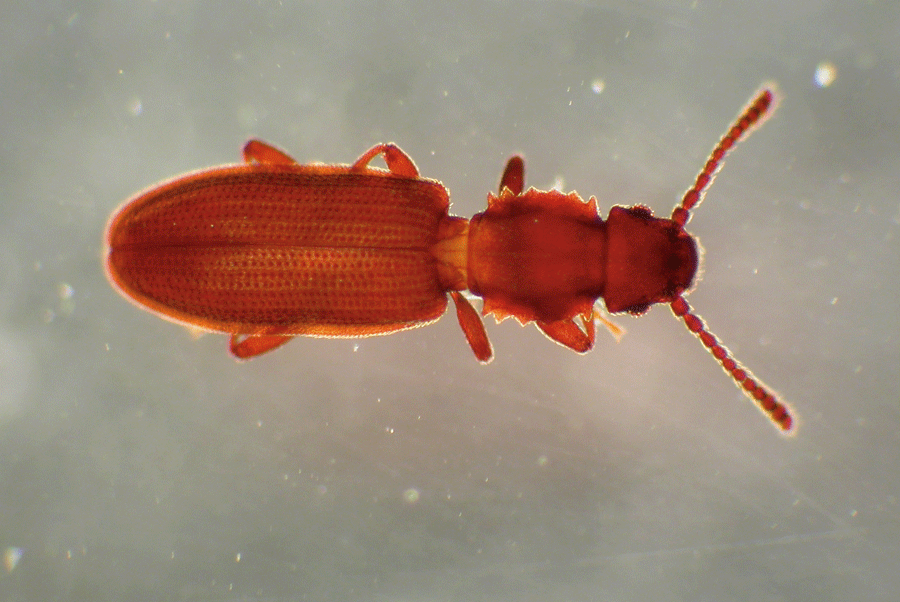 Figure 2B. Sawtoothed grain beetles get their name from the saw-like row of pointed teeth on either side of the body, just behind the head.
Figure 2B. Sawtoothed grain beetles get their name from the saw-like row of pointed teeth on either side of the body, just behind the head.
Red flour beetle
The red flour beetle, Tribolium castaneum, is 1/8 to 3/16 inch long, flattened, dark cherry to dark brown in color with gradually-clubbed antennae (Figure 3B). These long-lived beetles are serious pests of grain processing facilities and food warehouses but can also be found in grocery stores and home cupboards. Flour beetles cannot eat sound, intact kernels of grain. The grain must be damaged or milled (i.e., flour). Females may lay up to 1,000 eggs during their lifespan, which may last several years under ideal conditions. Because adult red flour beetles are very active, can fly, and are sometimes attracted to light, they disperse very easily from their initial infestation point. Adult beetles consume food.
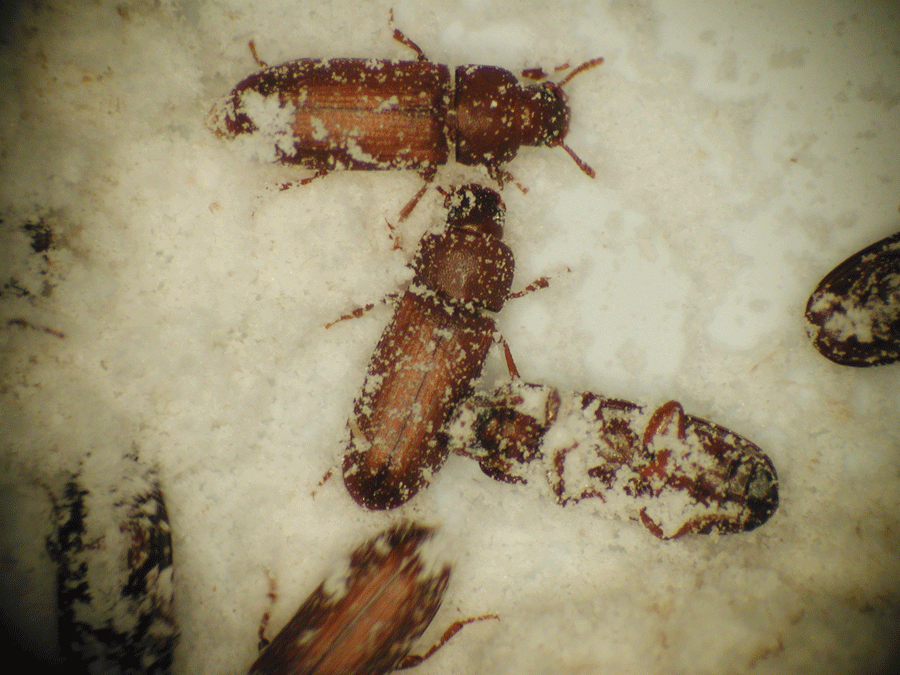 Figure 3A. Flour beetles (shown here in wheat flour) are approximately 1/8 to 3/16 inch long and dark cherry to dark brown in color.
Figure 3A. Flour beetles (shown here in wheat flour) are approximately 1/8 to 3/16 inch long and dark cherry to dark brown in color.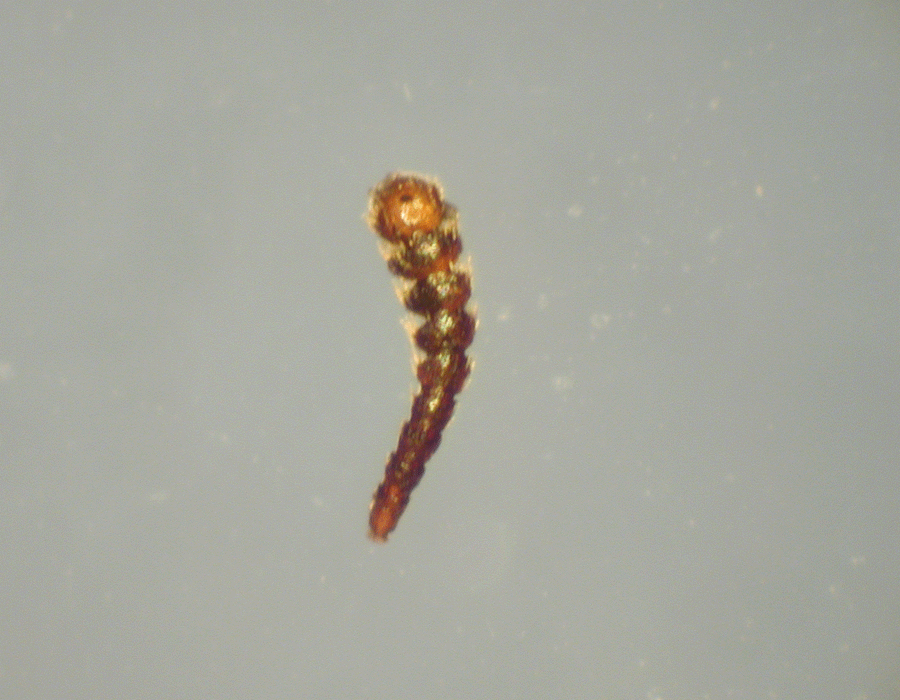 Figure 3B. Adult flour beetles have gradually-clubbed antennae.
Figure 3B. Adult flour beetles have gradually-clubbed antennae.
Rice weevils
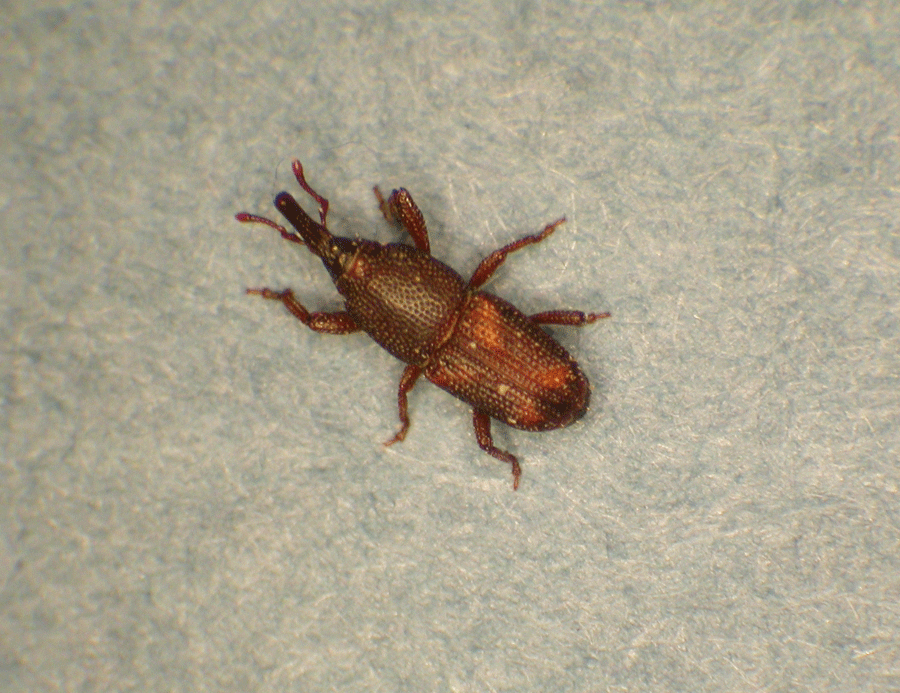 Figure 4.Adult rice weevils (approximately 1/8 inch long) are easily recognized by their long snout and by the four pale spots on their wing covers. Rice weevils typically infest whole kernel foods, such as corn or "Indian corn."
Figure 4.Adult rice weevils (approximately 1/8 inch long) are easily recognized by their long snout and by the four pale spots on their wing covers. Rice weevils typically infest whole kernel foods, such as corn or "Indian corn."Rice weevils, Sitophilus oryzae, are dark reddish-brown beetles, and can be identified by the presence of a pair of large, pale spots on each wing cover. The faint spots can be highlighted by slight moistening of the wing covers. Notably, the weevil's body is covered with small, round pits or indentations. As is common in weevils, they also have a long snout (Figure 4). The larvae generally require a food source with a hard or semi-hard coating in which to develop properly (e.g., corn kernels, rye, barley, cereals, wheat, dried peas, beans, nuts, bird seed, or rice). Adult female weevils lay eggs in whole kernel grains, such as corn, by first chewing a small depression in the kernel, depositing an egg in the depression, and then sealing the egg inside with a gelatinous plug that they produce. When the larva hatches from the egg, it starts consuming the inside of the kernel. The larva continues to feed and grow inside the kernel. All larval stages of the beetle are spent inside the kernel, obscured from the naked eye. The last larval instar pupates, and the adult weevil emerges from the kernel several days later, leaving a small, round hole in the kernel.
Like drugstore beetles, rice weevils can be found both in food (kitchen) and non-food areas of homes because of their mobility (adults readily fly) and the variety of items they are capable of infesting, including decorative items containing grains and nuts. Adults are long-lived (3 to 6 months) and feed on a wider variety of items than larvae. They sometimes "play dead" when disturbed.
Cowpea weevil
Cowpea weevil, Callosobruchus maculatus, adults have long antennae and long legs with an enlarged femur on the hind leg that bears a single, large tooth. The wing covers of the weevil have a large, rounded spot at mid-length. They do not completely cover the abdomen, leaving part of it exposed (Figure 5). Like rice weevils, cowpea weevil adults sometimes play dead when disturbed.
 Figure 5A. Adult cowpea weevils have long legs, long antennae, and abbreviated wing covers that do not completely cover the abdomen.
Figure 5A. Adult cowpea weevils have long legs, long antennae, and abbreviated wing covers that do not completely cover the abdomen.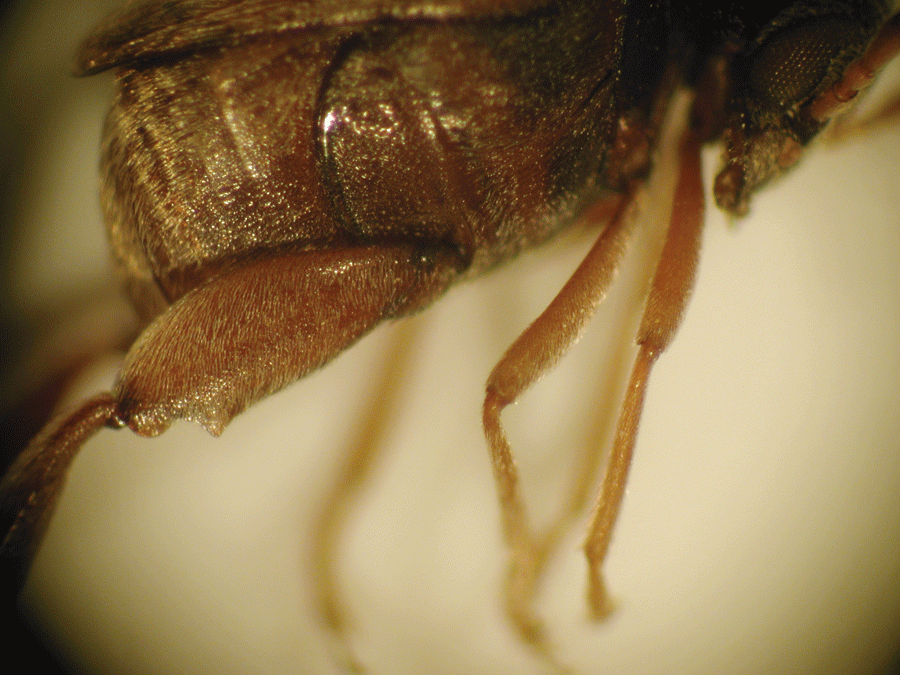 Figure 5B. Adults also have an enlarged femur on the hind leg that bears a single, large tooth.
Figure 5B. Adults also have an enlarged femur on the hind leg that bears a single, large tooth.
Cowpea weevils lay eggs on leguminous seeds such as chickpea, pigeon pea, garden peas, mung beans, cowpeas, black-eyed peas, soybeans, peas, lima beans, lentils, etc. The eggs hatch and the first instar larva then burrows into the seed to begin consuming it from the inside. All larval stages are spent inside the seed, where they remain concealed and protected as they feed. The last instar larva pupates inside the seed. After emergence from the pupa, the adult beetle chews its way out of the seed, leaving a characteristic round hole in the seed's shell (Figure 6). Although adults are short-lived and do not feed, they are very active, known to run rapidly, and are strong fliers.
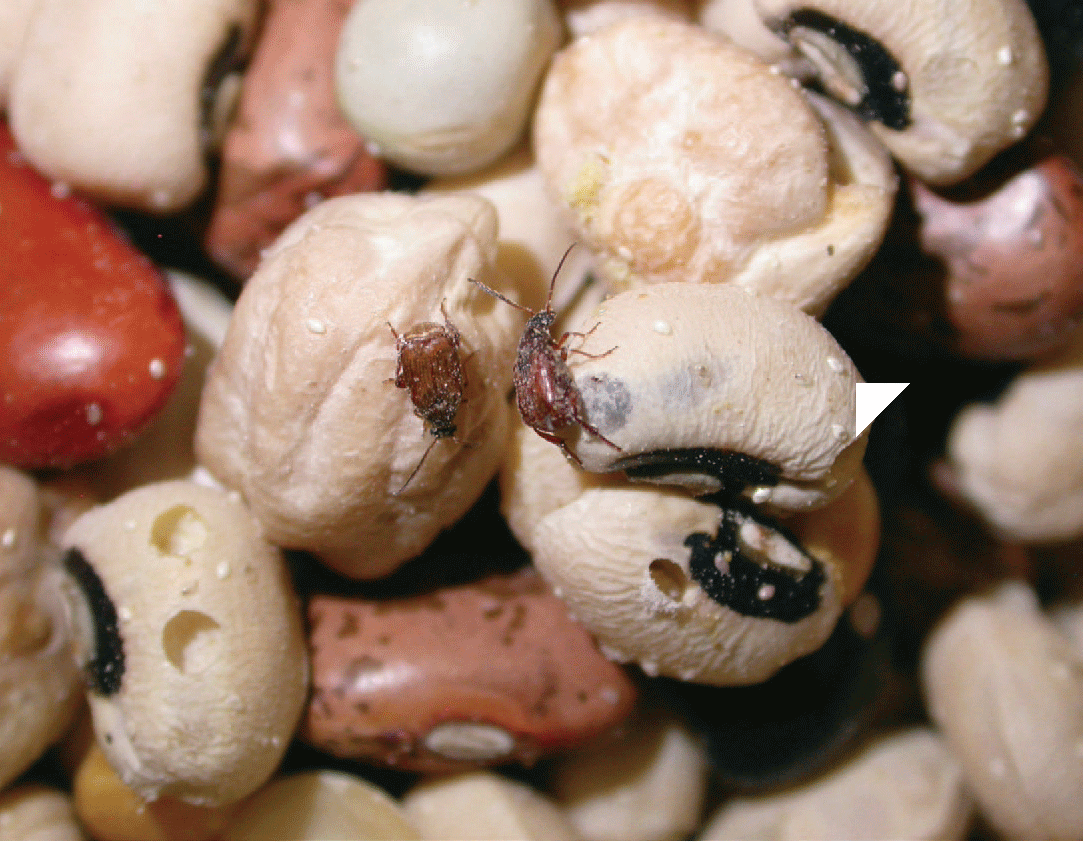 Figure 6. Some stored product beetles, such as cowpea weevils (pictured above) and rice weevils, leave a characteristic round hole in the items they infest. After emergence from the pupa while still inside the bean or seed, the adult beetle must then chew its way out of the infested item to free itself, leaving a characteristic round hole in the process. Arrow indicates egg.
Figure 6. Some stored product beetles, such as cowpea weevils (pictured above) and rice weevils, leave a characteristic round hole in the items they infest. After emergence from the pupa while still inside the bean or seed, the adult beetle must then chew its way out of the infested item to free itself, leaving a characteristic round hole in the process. Arrow indicates egg.
Warehouse beetle
The warehouse beetle, Trogoderma variabile, is one of several species of beetle in the genus Trogoderma that are considered pests of stored products (Figure 7A). It is the most common Trogoderma pest in southern homes. The warehouse beetle is oblong to oval, 1/8 to 3/16 inch long, with a dark and light mottled pattern on their wing covers. Adult Trogoderma are fairly short-lived and rarely feed on stored products. However, they are considered excellent fliers and can disperse quite easily. Typical of some other dermestid species (e.g., carpet beetles), larvae are covered with tufts of long hair. In addition, hairs on the last several abdominal segments of the larvae are dark red to cinnamon colored (Figure 7B). Larvae are capable of penetrating common packaging materials, boxes, and bags (Figure 7C). Severe infestations are often characterized by an abundance of cast larval skins, live larvae of various sizes (ages), and adults, all on the same food item (Figure 7D). The cast larval skins, cadavers, and debris from Trogoderma infestations can be allergenic (Figure 7D).
When food becomes scarce or disappears altogether, Trogoderma larvae may enter a lengthy period of inactivity known as diapause, where insects are completely inactive and do not feed. When larvae break diapause they can resume infesting food items. This ability to diapause in the absence of food combined with the ability to chew through packaging can make control of Trogoderma beetles very difficult.
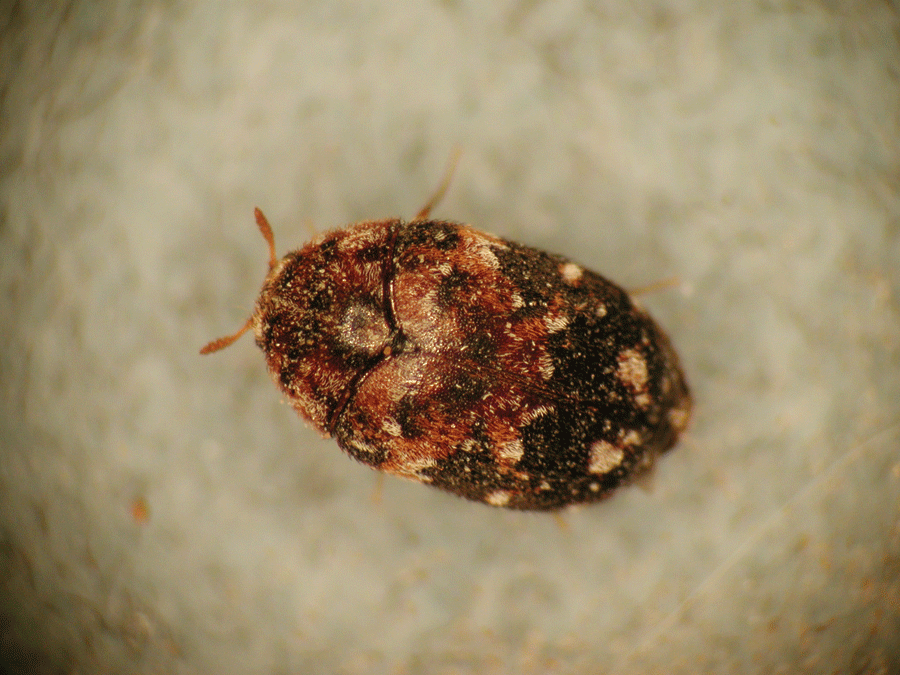 Figure 7A. Trogoderma beetles, such as the warehouse beetle, are oval shaped, 1/8 to 3/16 inch long and mottled in color. The wings are covered with fine hairs.
Figure 7A. Trogoderma beetles, such as the warehouse beetle, are oval shaped, 1/8 to 3/16 inch long and mottled in color. The wings are covered with fine hairs.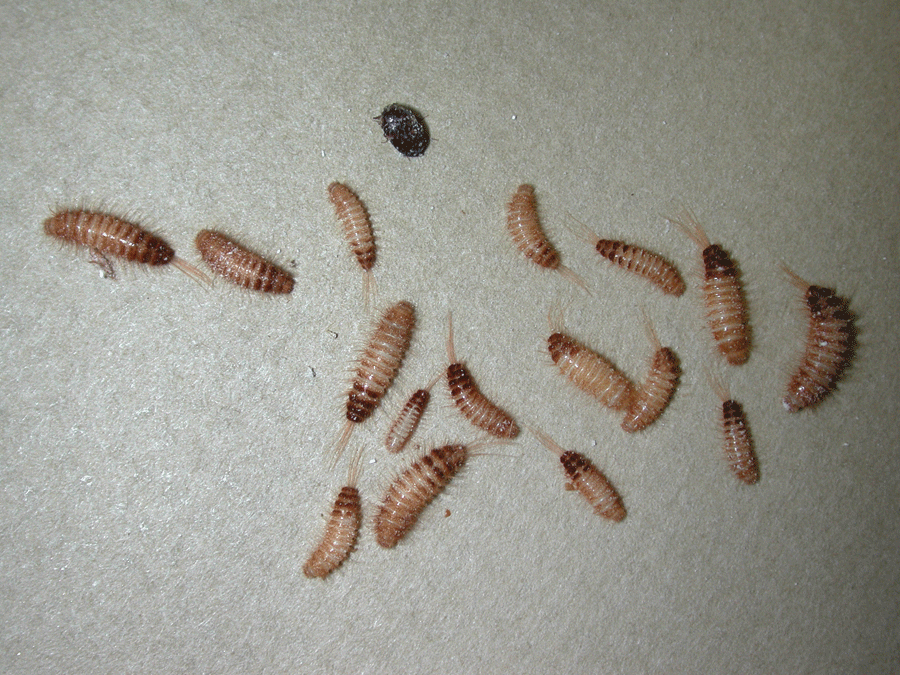 Figure 7B. Trogoderma larvae are covered with tufts of long hairs. Additionally, the hairs on the last several abdominal segments are dark red to cinnamon colored.
Figure 7B. Trogoderma larvae are covered with tufts of long hairs. Additionally, the hairs on the last several abdominal segments are dark red to cinnamon colored.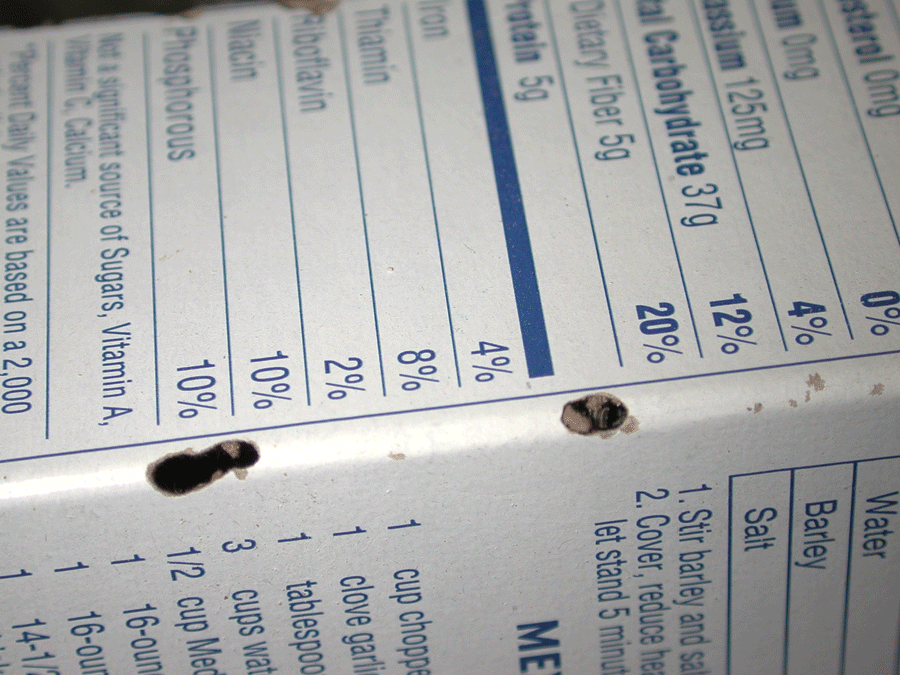 Figure 7C. Trogoderma larvae are capable of chewing through cardboard boxes to get to food sources inside.
Figure 7C. Trogoderma larvae are capable of chewing through cardboard boxes to get to food sources inside.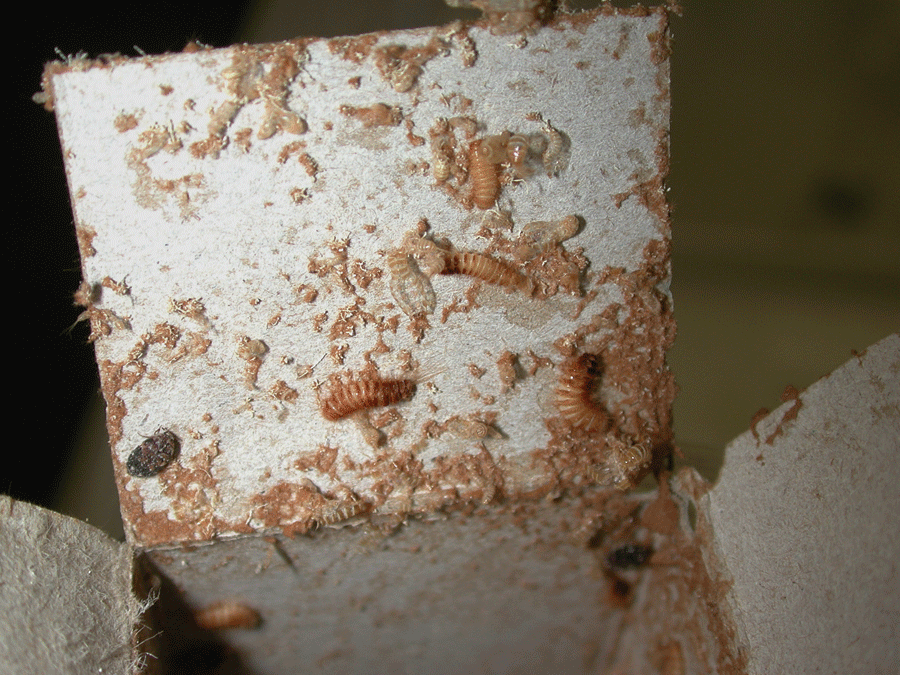 Figure 7D. Severe infestations of warehouse beetles are often characterized by an abundance of cast larval skins, live larvae of various sizes, and adults found infesting the same item.
Figure 7D. Severe infestations of warehouse beetles are often characterized by an abundance of cast larval skins, live larvae of various sizes, and adults found infesting the same item.
Drugstore Beetle
The adult drugstore beetle, Stegobium paniceum, has its head concealed and protected inside a helmet-like covering called the pronotum. Because it is concealed, the head is not visible when viewed from above. Adult drugstore beetles are light brown to tan, have hairy wing covers marked with longitudinal rows of pits, and antennae that end with three broadened segments (Figure 8A & 8B). In homes, drugstore beetles commonly infest dried herbs and spices as well as dry pet food, dog bones, rodent bait, dried flowers and plant material, books, taxidermy mounts, etc. (Figure 8C & 8D). Drugstore beetles can chew through packaging such as paperboard boxes, bags, and aluminum foil. Adult drugstore beetles are active, readily fly (are mobile), and are attracted to lights. Because of these behaviors, drugstore beetles can be found in areas away from the source of the infestation, often near windows and lights. Under these circumstances, a more thorough search may be needed to find the ultimate source of the drugstore beetle infestation. Damage from drugstore beetles includes characteristic round holes in infested materials made by adult beetles as they emerge from an infested item (Figure 8C & 8D). Like the weevils, drugstore beetles may feign death when disturbed. Adults are short-lived and feed little or not at all.
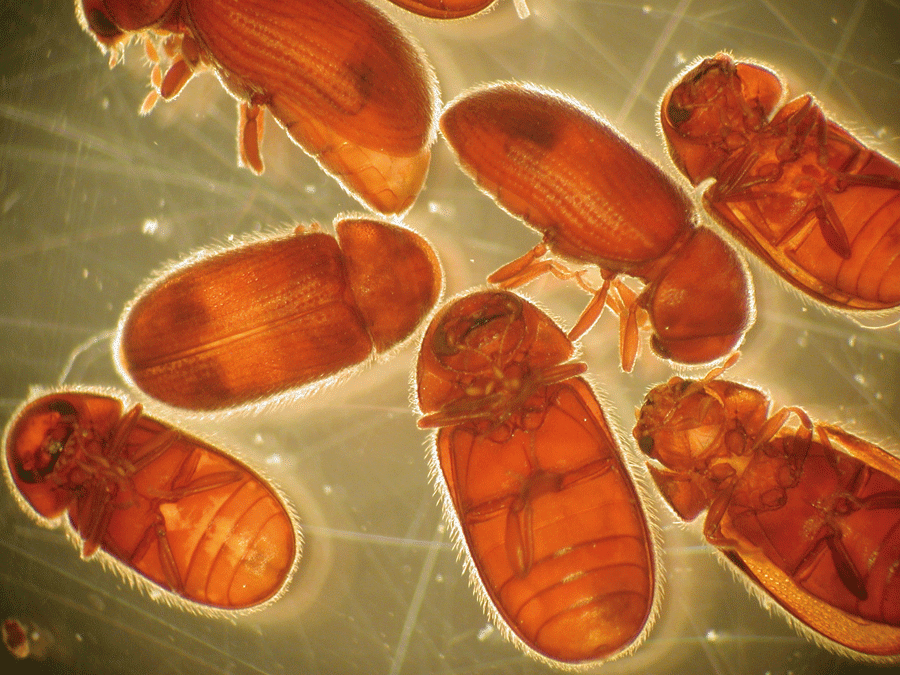 Figure 8A. Drugstore beetles are approximately 1/8 inch long, light brown to tan, and covered with small, golden hairs. Wing covers are characterized by longitudinal rows of pits or indentations.
Figure 8A. Drugstore beetles are approximately 1/8 inch long, light brown to tan, and covered with small, golden hairs. Wing covers are characterized by longitudinal rows of pits or indentations.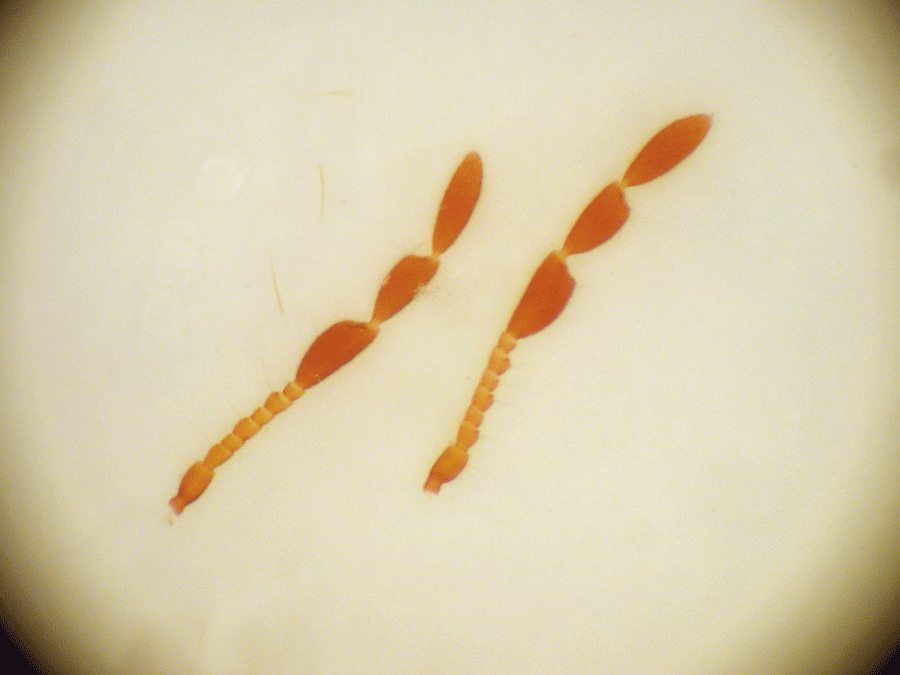 Figure 8B. Adult drugstore beetle antennae end in three expanded segments. Drugstore beetles consume almost anything of plant or animal origin, including, for example, (8C) dog treats and (8D) dried peppers.
Figure 8B. Adult drugstore beetle antennae end in three expanded segments. Drugstore beetles consume almost anything of plant or animal origin, including, for example, (8C) dog treats and (8D) dried peppers.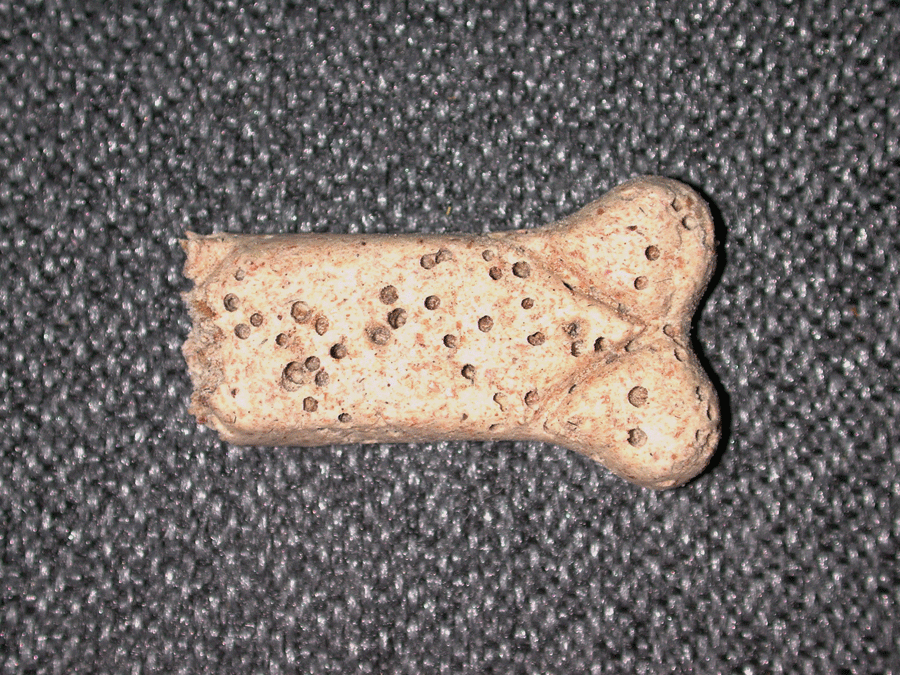 Figure 8C. Dog treats. Note round exit holes made by adult beetles as they emerged from the infested item.
Figure 8C. Dog treats. Note round exit holes made by adult beetles as they emerged from the infested item.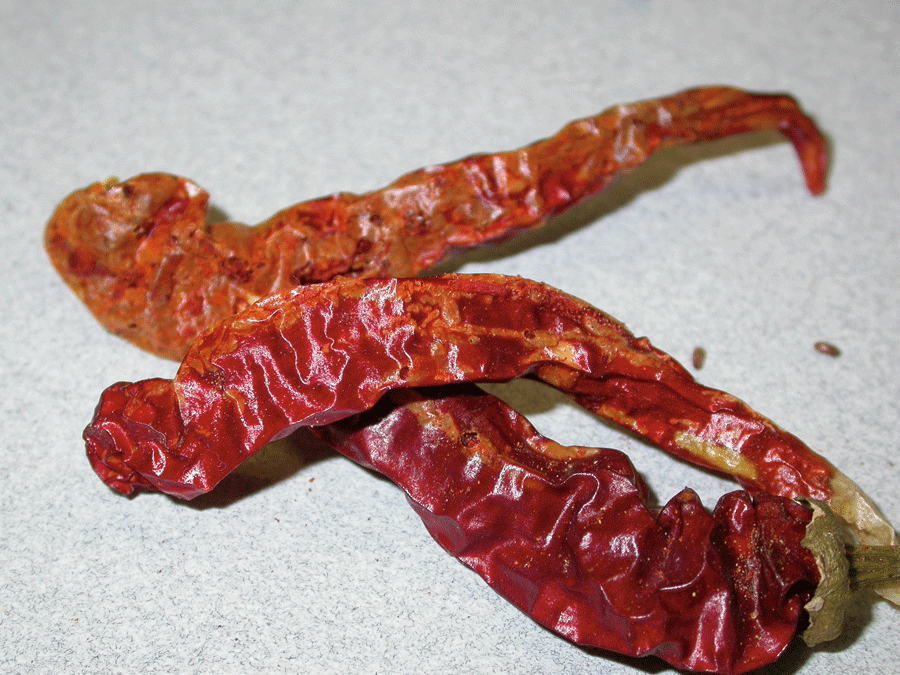 Figure 8D. Dried peppers. Note round exit holes made by adult beetles as they emerged from the infested item.
Figure 8D. Dried peppers. Note round exit holes made by adult beetles as they emerged from the infested item.Solving a Current Infestation of Stored Product Pests
To stop a current infestation of a stored product pest, the source of the insects must be found and eliminated. Otherwise, the problem is likely to persist. The infestation can be stopped by finding and removing the insect's food source(s), vacuuming (or removing) food crumbs from hard-to-reach locations in the cupboard and, when appropriate, eliminating infestations from items deemed non-disposable, such as those with sentimental value.
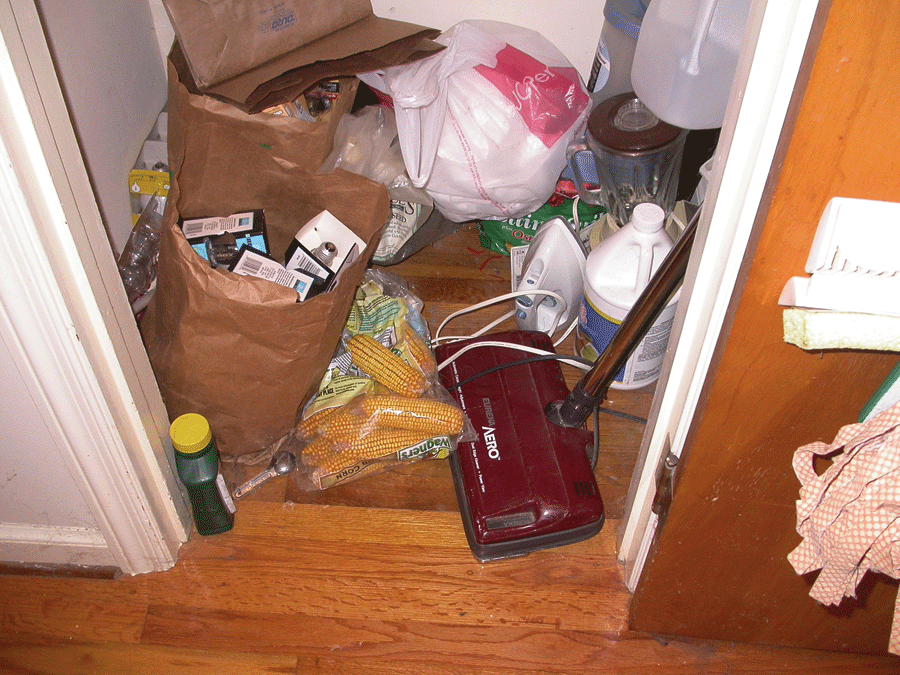 Figure 9. Because of their mobility, infestations of stored product pests can spread into areas well away from their original point of origin (often the kitchen, cupboard, or food storage closet). When seeking out the source of a stored product pest, if the infestation cannot be found in the kitchen, look elsewhere. In this photograph, stored product pests were found infesting corn (bird and squirrel food) that had been stored in a utility closet and forgotten.
Figure 9. Because of their mobility, infestations of stored product pests can spread into areas well away from their original point of origin (often the kitchen, cupboard, or food storage closet). When seeking out the source of a stored product pest, if the infestation cannot be found in the kitchen, look elsewhere. In this photograph, stored product pests were found infesting corn (bird and squirrel food) that had been stored in a utility closet and forgotten.To find insect-infested material, inspect all items listed previously as susceptible to infestation, beginning with those potential sources closest to where most of the adult insects are found. When inspecting open food containers in the cupboard, it is advisable to lightly shake each item. Although stored product pests may not be immediately visible upon inspection, the physical act of shaking often brings small beetles to the surface of the infested food item, where they can then be easily detected. If the source(s) of insects cannot be found where food is stored (i.e., kitchen, cupboard, or food storage closet), then look elsewhere. Items not considered human food may support a population of a stored product pest. Bird seed and dry pet food are common sources of stored product pest infestations (Figure 9). Other sources may include wall and table decorations, ornaments, pot pourri, and jewelry that contains items of plant or animal origin (Figure 10). When an infested item is found and the decision to discard it is made, the item should be tightly sealed within a bag and immediately placed in an outdoor trash receptacle for removal.
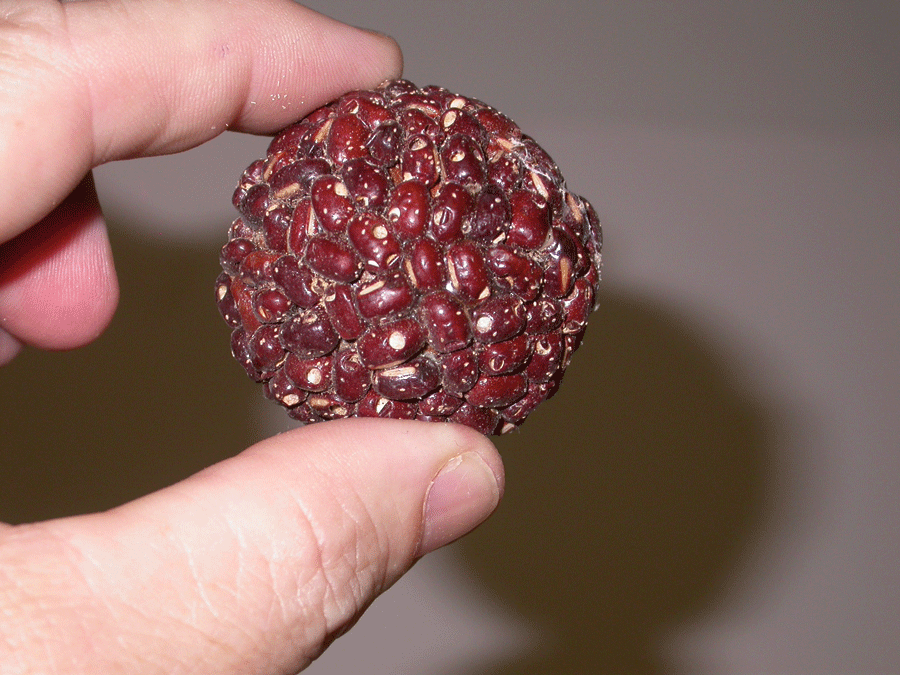 Figure 10A. When looking for the source of a stored product pest infestation, inspect all items containing materials of animal or plant origin, including decorative items such as this ornament made from beans.
Figure 10A. When looking for the source of a stored product pest infestation, inspect all items containing materials of animal or plant origin, including decorative items such as this ornament made from beans.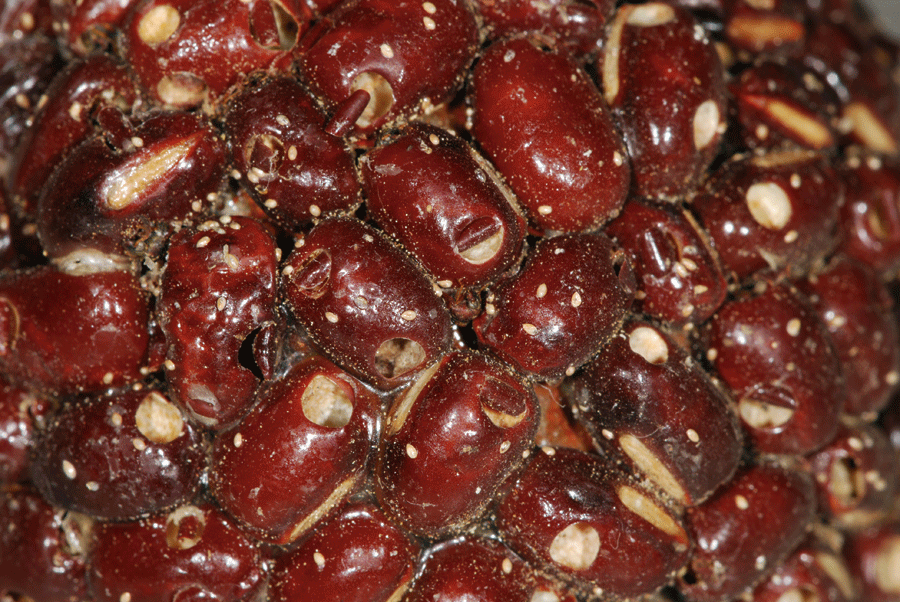 Figure 10B. Closeup of holes in beans from which cowpea weevils emerged.
Figure 10B. Closeup of holes in beans from which cowpea weevils emerged.
The mobility of stored product pests is an important factor to consider when searching for the source(s) of an infestation. The adults of some species are excellent fliers, very active, and perhaps attracted to lights. Because of their mobility, infestations (or simply individual adults) can spread into areas well away from their original point of origin or primary breeding site (Figure 9). The adult stage of stored product pests should be viewed as the stage that initiates and spreads the infestation. Adults are also the most commonly seen stage. In contrast, larvae are mostly confined to the food item(s) they infest, and are rarely seen.
In homes, insecticides can be used to reduce visible populations of adult insects. However, if the only effort at solving the infestation is treatment of adults with insecticides, the problem is not likely to be solved. The infestation will likely persist unless infested material is found and removed, and packages of opened food items are protected from infestation.
If an insecticide is used, it is important to first read the product's label to determine how it can and cannot be used. Insecticides should never be applied directly to consumable food items.
Infestations of items that cannot be discarded (e.g., items with sentimental value, jewelry and home/seasonal décor containing items of plant or animal origin) can be eliminated by exposure to extreme cold. Infested items can be placed in a household freezer and held for six days at 0°F to -2°F (warehouse beetle infestations may require longer exposures), keeping in mind that the efficacy of extreme cold as a control method is dependent upon a number of variables, including temperature achieved at the infestation site, time held at target temperature, insect species, and degree of insect protection inside infested items (insulates insects from extreme temperatures).
Preventing Future Infestations of Stored Product Pests
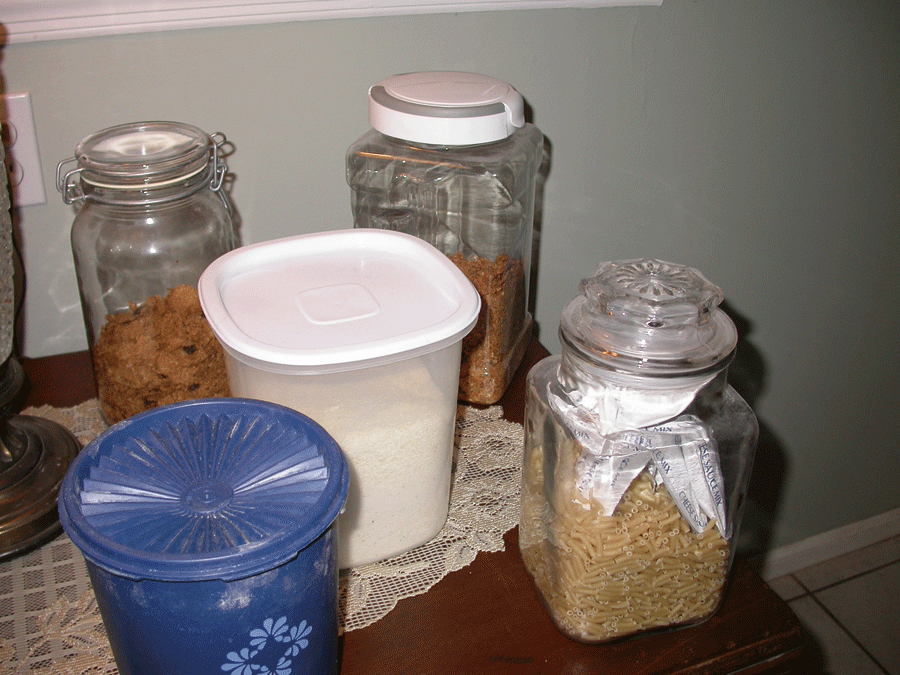 Figure 11. To prevent future infestations or the spread of a current infestation, it is advisable to store open packages of food in containers with tight-sealing lids.
Figure 11. To prevent future infestations or the spread of a current infestation, it is advisable to store open packages of food in containers with tight-sealing lids.Sanitation plays a very important role in denying stored product pests access to food sources, and thus preventing future infestations. To prevent future infestations, including the spread of current infestations, food should be stored in tightly-sealed containers or in a refrigerator or freezer (Figure 11). The date of purchase of commonly used food items should be written on packages before placement in the cupboard. Older packages should be consumed before newly-purchased foods. Dry pet food, especially bird seed, should also be stored in tightly-sealed containers. The origin of many stored product pest infestations in cupboards (especially Indianmeal moth and sawtoothed grain beetle) is infested bird seed purchased and brought into the home. Therefore, it is advisable to keep bird seed in tightly-sealed containers, and stored away from the kitchen, to prevent the movement of stored product pests into the cupboard. Spilled food that might serve as sustenance for stored product pests should be vacuumed or otherwise removed from cupboards and other food storage areas. Because the adults of some stored product pests are long-lived (6-8 months), highly mobile, excellent at locating susceptible food sources (by odor), and capable of chewing through sealed packaging or entering small openings and opened packages to reach the food inside, it is important to commit to these preventive practices early and for the long term.
Traps
Traps for stored product pests are baited with an attractant that is released from a point source typically housed in a small cardboard or plastic container. The area surrounding the attractant is covered by a thin layer of sticky glue or oil. When target insects approach the source of the attractant they become stuck in the glue or oil, and cannot escape (Figure 12). Traps should be used to detect the presence and density of pests and to monitor the success of control attempts, but they are not useful for reducing population density or eliminating an infestation. It is important to read and follow the manufacturer's written instructions regarding the number and placement of traps. For example, traps become much less attractive to insects when they become dirty or densely covered with insects.
Several types of attractants are used in traps. Pheromones are highly volatile chemicals produced by insects to communicate specific behaviors to other insects of the same species. One of the most common behaviors mediated by pheromones is mate attraction via the production of sex pheromones. Sex pheromones are typically released by female insects to attract males for the purpose of mating. Because of this, most traps containing sex pheromones trap only male insects. Scientists have identified and synthesized the sex pheromone of many economically-important insects, including several stored product pests. These synthetic chemicals have been incorporated into traps as lures to attract and trap male insects of the target species. Most insects are highly sensitive to sex pheromones. The use of too many sex pheromone traps can saturate the environment with too much attractant, thereby confusing the target insect and reducing the effectiveness of the trap. It is therefore imperative to use no more traps than recommended by the manufacturer.
Another type of pheromone used in traps for stored product pests is an aggregation pheromone. Aggregation pheromones elicit an aggregation response (by both sexes) among target insects. A third type of attractant used in traps for stored product pests is food lures, or chemical attractants that mimic the odor of the target pest's preferred food source. Food lures are effective when the pest species is not known in advance or a specific pheromone is unavailable.
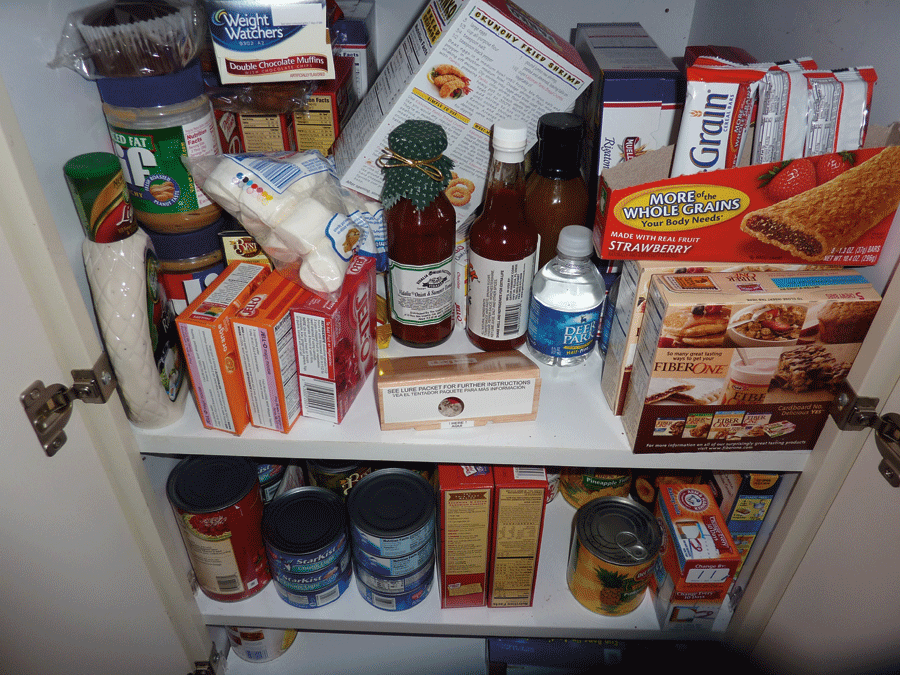 Figure 12A. Traps are commonly used to detect the presence of various stored product pests in homes. They should be placed in areas where insects are seen.
Figure 12A. Traps are commonly used to detect the presence of various stored product pests in homes. They should be placed in areas where insects are seen.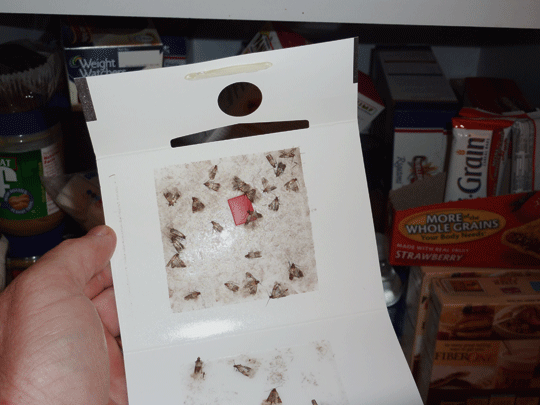 Figure 12B. Traps work by attracting and then trapping the insects onto a sticky substance, often glue or oil, that surrounds the attractant (red square). The attractant is most often a chemical pheromone (mating attractant) or food odor that mimics the insect's preferred food source. Always follow the manufacturer's directions regarding trap use.
Figure 12B. Traps work by attracting and then trapping the insects onto a sticky substance, often glue or oil, that surrounds the attractant (red square). The attractant is most often a chemical pheromone (mating attractant) or food odor that mimics the insect's preferred food source. Always follow the manufacturer's directions regarding trap use.
Summary
Numerous species of small beetles and moths, referred to as stored product pests, commonly infest food and non-food items in the home. The most common stored product pest found in homes is the Indianmeal moth. Often, the first indication of a stored product pest infestation is the discovery of infested food items or the sudden, and then persistent, presence of small insects in a particular area of the home. If unaddressed, infestations of stored product pests can spread rapidly into other parts of the home, making control very difficult. Because some pests of stored products are long-lived, highly mobile, attracted to the odor(s) of susceptible food sources, and capable of chewing through packaging, when an infestation is suspected it is important to inspect all items susceptible to infestation so that the source of the infestation can be removed. Ultimately, the key to resolving an infestation of a stored product pest is to find the infested item(s) and either dis-infest or discard it. Unless the infested item(s) are found, the infestation is likely to continue. Proper sanitation, food storage, and removal of infested items are the keys to halting an infestation of stored product pests. Insecticides can be used to eliminate populations of visible adults, but they alone are unlikely to eliminate a pest problem. Insecticides should never be applied directly to consumable food items. Traps, baited with various attractants (pheromones or food lures), can be used as a means to monitor the effectiveness of control attempts, but they should not be used as a sole means of control.
Finally, if homeowners experience an ongoing infestation of stored product pests, it is advisable to seek the advice and services of a pest management professional. In addition to specific knowledge and experience regarding stored product pests and their control, pest management professionals also may utilize tools not available to the homeowner. Regardless of the company hired, the technician should conduct a thorough and complete inspection that results in an exact or likely location of infested material(s). Although locating infested material is not always easy, it is the key to eliminating a stored product pest infestation.
Should homeowners have questions regarding a stored product pest infestation in Georgia contact your local county Extension agent by calling 1-800-ASK-UGA1 or visit the University of Georgia's Extension website at extension.uga.edu
Acknowledgments
The authors wish to thank Frank Arthur (USDA-ARS), Stephen Kells (University of Minnesota), Austin Frishman (AMF Pest Management Services, Inc.), Dave Buntin and Wayne Gardner (University of Georgia), Wade Hutcheson (Georgia Cooperative Extension), and James Sargent (Copesan Technical Committee) for their thoughtful review of this bulletin.
Useful References
Bennett, G. W., Corrigan, R. M., & Owens, J. M. (2003). Chapter 10: Stored product pests. In Truman’s scientific guide to pest management operations (6th ed., pp. 237–254). Advanstar Communications.
Hedges, S. A., & Lacey, M. S. (2002). PCT field guide for the management of structure-infesting beetles: Volume II: Stored product beetles/occasional and overwintering beetles (2nd ed.). Franzak & Foster.
Merchant, M. E. (2000). Stored product pests. In R. E. Gold & S. C. Jones (Eds.), Handbook of household and structural insect pests (pp. 88–98). Entomological Society of America.
Rees, D. (2004). Insects of stored products. CSIRO Publishing. https://www.publish.csiro.au/book/3465/
Smith, E. H., & Whitman, R. C. (2007). NPMA field guide to structural pests (2nd ed.). National Pest Management Association. https://ebiz6personal.npmapestworld.org/UI/ProductDetails.html?productId=703
VanRyckeghem, A. (2004). Chapter 13: Stored product pests. In S. A. Hedges & D. Moreland (Eds.), Mallis handbook of pest control: The behavior, life history, and control of household pests (9th ed., pp. 747–823). GIE Media.
Status and Revision History
Published on Feb 03, 2011
Published with Full Review on Feb 01, 2014
Published with Full Review on Mar 28, 2017
Published with Full Review on May 23, 2023


























































